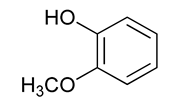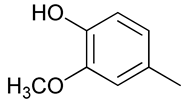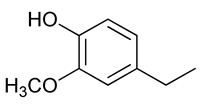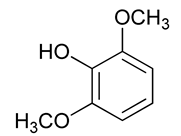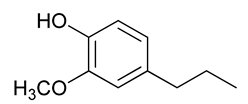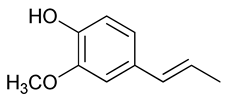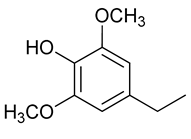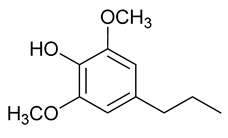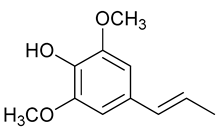Abstract
Thermal conversion of flax shives was studied in sub- and supercritical ethanol medium at 225 and 250 °C in the presence of the bifunctional catalyst 3% Ru/C. The use of 3% Ru/C catalyst in the process of thermal conversion of flax shives in supercritical ethanol was found to increase the conversion of the shives by 27% and the yield of liquid products by 10%. The use of 3% Ru/C catalyst in sub- and supercritical ethanol led to the destruction of both lignin and cellulose. The degree of delignification in the non-catalytic thermal conversion increased upon transition from subcritical (225 °C) to supercritical (250 °C) conditions. Main monomeric products of the thermal conversion process were guaiacylpropene or guaiacylpropane depending on the process temperature. In the presence of Ru/C catalyst, the molecular weight distribution was shifted towards an increase in the content of monomeric compounds in the liquid products.
1. Introduction
Global warming and its environmental impact have given an impetus to the development of ecologically sound processes with agricultural wastes such as a lignocellulosic biomass for social and economic sustainability [1,2].
Flax shives are the main waste (up to 70 wt.%) of the production of flax fiber. These are the lignified parts of the flax stem, mainly in the form of small straws. Flax shives contain ca. 25% lignin, 50% cellulose, and 20% hemicelluloses [1,3]. Lignin consists mainly of phenylpropane structural units formed by oxidation of coniferyl, sinapyl, and p-coumaryl alcohols linked by C-O and C-C bonds, among which the ester β-O-4 bond predominates [4].
Intensive R&D efforts are focused on new methods for the processing of lignins and biomass to components of engine fuels and chemicals [5,6,7]. One of these methods is the thermocatalytic conversion of lignocellulosic biomass; it is based on one-pot extraction and depolymerization of lignin [8,9,10]. Against non-catalytic thermal dissolution of biomass lignins in aliphatic alcohols, the depolimerization over solid catalysts Ru/C [11], Pt/C, Rh/C [12,13], ZnPd/C [14,15], and Ni/C [13,16] leads to a significant increase in the lignin conversion and an increase in the yields of monomeric and dimeric products.
A 3% Ru catalyst supported on the carbon material Sibunit was shown before to be active to depolymerization and hydrogenolysis of birch ethanol lignin [17], abies wood and abies ethanol lignin [18], aspen wood and aspen ethanol lignin [19], and flax shives [20].
Ethanol can be obtained from lignocellulosics; it is cheap and environmentally benign. Ethanol and lower aliphatic alcohols with hydrogen-donor properties are usually used as organic solvents [9,11]. In the process of catalytic hydrogenolysis they donate hydrogen to lignin structures and extract the products of lignin fragmentation, simultaneously alkylate and reduce intermediates, decreasing the contribution of secondary reactions of their condensation [21,22,23].
The present study was aimed at comparing processes of thermal conversion of flax shives in the sub- and supercritical ethanol in order to establish the influence of the Ru/C catalyst and hydrogen gas on the conversion of lignin, yields and composition of liquid and solid products.
2. Results and Discussion
2.1. Catalytic Thermal Conversion of Flax Shives in Sub- and Supercritical Ethanol
Experimental results on the thermal conversion of flax shives in sub- and supercritical ethanol in the absence and in the presence of the Ru/C catalyst are presented in Table 1 and Table 2.

Table 1.
The effect of the catalyst and the process conditions on the yield of products of thermal conversion of flax shives.

Table 2.
Composition of a solid product, degree of delignification and cellulose yield in processes of noncatalytic and catalytic thermal conversion of flax shives.
In the non-catalytic process, elevation of the temperature up to 250 °C leads to a decrease in the yield of liquid and solid products and to an increase in the yields of methoxyphenols. In the presence of the catalyst under subcritical conditions (225 °C), the conversion of flax shives increases by 5% but the yield of liquid products is practically not changed. Maximum conversion (76.8), the yield of a liquid product (29.7 wt.%) and monomeric methoxyphenols (3.77% based on lignin content in flax shive) is attained with the catalyst under supercritical conditions at 250 °C.
Comparison of the data [20] and the obtained results show that the use of hydrogen in catalytic thermal conversion of flax shives leads to an increase in the conversion of both in subcritical (by 5.5%) and supercritical conditions (by 10.8%).
In the catalytic thermal conversion of the flax shives in the subcritical ethanol, against the non-catalytic process, the delignification degree and the cellulose yield increases by 19.7% and by 10.7%, respectively, at the content of hemicellulose in a solid product decreased by 8.1% (Table 2). A temperature elevation of up to 250 °C results in a decrease in the cellulose yield (by 18.6%) and in an increase in the degree of delignification (by 12.3%).
Thus, the catalyst provides an increase in the degree of delignification and the cellulose destruction in supercritical ethanol. In the non-catalytic thermal conversion, a transition from subcritical (225 °C) to supercritical (250 °C) conditions increases the degree of delignification and decreases the cellulose yield.
The addition of hydrogen (initial pressure is of 40 bar) in both the non-catalytic and catalytic process of thermal conversion of flax shives in the sub- and supercritical ethanol leads to an increase in the degree of delignification and destruction of cellulose (Table 2, [20]). Acceptable degrees of cellulose destruction (less than 50%) are only attained at a low temperature of 225 °C.
2.2. Composition of Liquid Products of Thermal Conversion of Flax Shives
GC-MS analysis of liquid products showed that guaiacol and syringol, as well as their alkyl and alkenyl derivatives, are the main products of thermal conversion of flax shives.
The maximum yields of guaiacol (1.4%) and syringol (0.6%) obtained by the non-catalytic hydrogenation (Figure 1) were higher than the yield of guaiacol in the catalytic process [20]. It is reasonable to conclude about the non-catalytic nature of the formation of these simplest products.
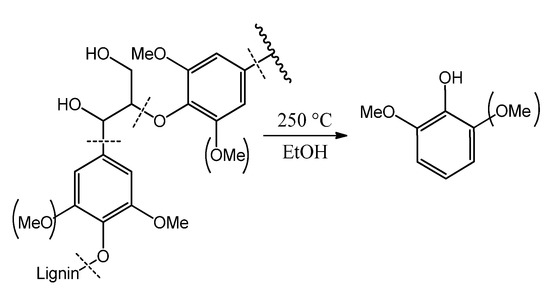
Figure 1.
Formation of guaiacol and syringol in non-catalytic thermal conversion of flax shives.
Good yields of propane and propene derivatives were only observed in the presence of the catalyst (Table 3). In the hydrogen-free thermal conversion, propenylguaiacol- and syringol were only reduced to the corresponding propyl substitutes at 250 °C (Figure 2), while these propenyl substitutes were hydrogenated with hydrogen even at a lower temperature (225 °C) [20].

Table 3.
The yield of monomeric products of thermal conversion of flax shives.
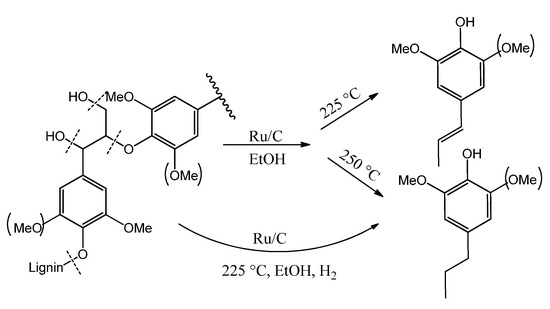
Figure 2.
Formation of propene and propane derivatives depending on the conditions of thermal conversion of flax shives.
Alcohols and hemicelluloses are known to behave as hydrogen donors [9,24,25]. However, the activity of these donors is insufficient for the hydrogenation of the propenyl group; therefore, propenylguaiacol and propenylsyringol were the main monomeric methoxyphenols from pine and birch wood without external hydrogen in a H2O/ethanol solvent at 195 °C [10]. Elimination of a hydrogen molecule from an alcohol molecule under these conditions is thermodynamically unfavorable, which may cause a lower efficiency of the propene reduction with alcohols.
In the non-catalytic process, the total content of the main monomeric compounds is 1.33 wt.%, in subcritical ethanol (225 °C) but as high as 3.5 times of that at 250 °C. In the presence of the catalyst, the total yield of monophenols is close to the maximum at the temperature, which is as low as 225 °C; as a result, the yield increases only slightly, from 8.6 to 9.9 wt.% at the temperature elevated to 250 °C (Table 3, Figure 3).
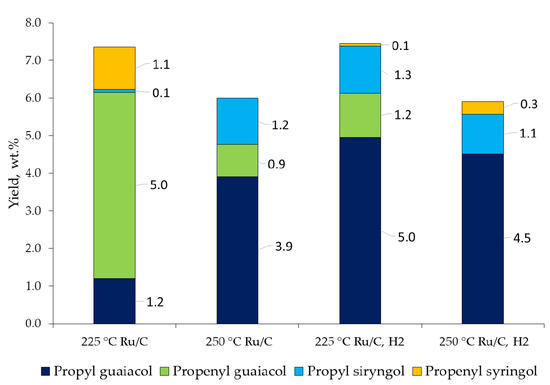
Figure 3.
Comparison of contents of the main phenolic components in the process of catalytic thermal conversion in sub- and supercritical ethanol (225 and 250 °C) with hydrogen gas (4 MPa) [20] and without it.
Note that the reduction of propenylguaiacol with ethanol at 250 °C is accompanied by a 30% decrease in the total content of propenyl and propyl derivatives, while the yield of ethyl guaiacol and ethyl syringol increases significantly. The comparative data indicate the possibility of partial β–γ–bond destruction through formaldehyde elimination, which is similar to a retroaldole reaction [26,27] or hydrogenolysis of the propyl substituent to the corresponding ethyl group under the considered conditions (Figure 4).
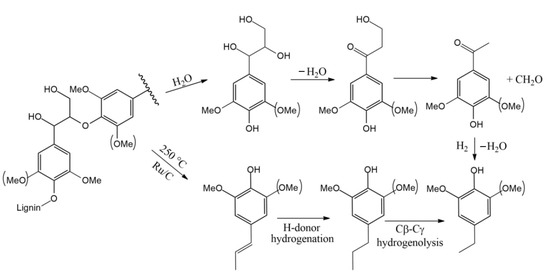
Figure 4.
Schematic of formation of ethyl guaiacol and syringol.
It should be noted that the maximum total yield of methoxyphenols upon thermal conversion of flax shives in the absence of molecular hydrogen (11.69%) at 250 °C exceeds those (9.73 wt.%) reported earlier [20], where flax shives were hydrogenated with H2. A similar relationship, i.e., an increase in the total yield of monomers in the processing of birchwood without external hydrogen compared to the hydrogenation process with H2, was shown elsewhere [24]. Perhaps, the solvent contacts the active catalytic sites to form easier active hydrogen species, because H2 gas must overcome the mass transfer resistance and adsorption equilibrium barriers of liquid-solid interface for activation [8,24].
Conditions of thermal conversion of flax shives significantly affect the molecular weight distribution of liquid products (Figure 5). The liquid products of the non-catalytic thermal conversion of flax shives consist of oligomers with admixtures of dimers and small amounts of monomeric compounds. Elevation of the process temperature leads to greater polydispersity (PD) of molecular mass of the products (Table 4).
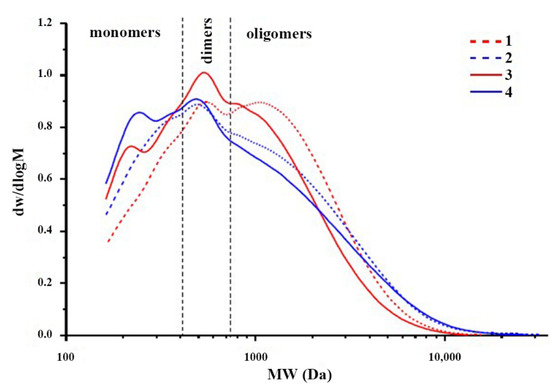
Figure 5.
Molecular weight distribution of liquid products of thermal conversion of flax shives at 225 °С without the catalyst (1), 250 °С without the catalyst (2), 225 °С with the catalyst (3), 250 °С with the catalyst (4).

Table 4.
Molecular masses of liquid products of the thermal conversion of flax shives.
The Ru/C catalyst increases monomers and dimers (especially at 225 °C) content and decreases the oligomers content in the area of the molecular weight above 1 kDa. Increasing the temperature leads to an increase of monomers and polymers content as a result of decreasing the dimers and oligomers quantities. Hence, depolymerization and repolymerization reactions occur in the process: the catalyst accelerates depolymerization, and increasing the temperature intensifies both the oligomers depolymerization and the monomers repolymerization.
3. Materials and Methods
3.1. Catalyst Preparation
Carbon supports were prepared by oxidation of powdered Sibunit®-4 carbon (15 g) with a mixture of O2 and N2 (20:80 vol%) in the presence of water vapor (saturation at 90 °C, vapor pressure 70.1 kPa, flow rate 200 mL/min) at 450 °C for 2 h.
Ruthenium catalysts supported on oxidized Sibunit®-4 (3% Ru/C, fraction 0.056–0.094 mm) were prepared by incipient wetness impregnation with an aqueous Ru (NO) (NO3)3 solution followed by sample drying at room temperature for 2‒3 h then at 60 °C for 12 h. The active component was reduced in flowing hydrogen (30 mL/min) at 300 °C for 2 h (temperature ramp: 1 °C/min). After cooling down to room temperature in hydrogen, the catalyst (2 g) was passivated using a gas mixture of 1% of O2 in N2 flow 30 mL/min [28].
Textural characteristics of the samples were determined from the N2 adsorption isotherms at 77 K with an automatic analyzer of specific surface area and porosity instrument (Micromeritics ASAP-2020 Plus, Norcross, GA, USA, 2018).
High-resolution electron microscopy images and the size distribution of ruthenium particles were acquired using a transmission electron microscope HT7700 (Hitachi, Tokyo, Japan, 2014) at the accelerating voltage of 110 kV and resolution of 2 Å. Particle size distribution histograms were obtained by statistical (500‒800 particles) analysis of the TEM images. Linear (<dl>) and weight-average diameters (<ds>) were calculated using the following formula:
where di is the diameter of a deposited particle, and N is the total number of particles.
<dl> = Σdi/N, <ds> = Σdi3/Σdi2,
The ruthenium dispersion DRu in the catalysts was calculated using the formula:
where MRu = 0.101 kg/mol is the ruthenium molar weight, ρ = 12,410 kg/m3 is the ruthenium metal density, αRu = 6.13 × 10−20 is the average effective area of the metal atom on the surface (m2), N0 is the Avogadro number, and ds is the weight-average diameter of ruthenium particles [29].
The catalyst acidity was estimated by the point of zero charge (pzc) by the Sorenson–de Bruyn method [30].
Characteristics of the ruthenium catalyst: the linear particle size, <dl> = 1.13 ± 0.01 nm; the dispersion of ruthenium, DRu = 0.94; specific surface area, SBET = 341 m2/g; pore volume, Vp = 0.50 cm3/g; average pore size, <dp> = 5.88 nm; рНpzc 6.89.
3.2. Flax Shives Samples Preparation
Flax shives (growing region—Tver region, Russia) were provided by the Tver State Technical University. Air dried flax shives were ground in a VR-2 disintegrator (Russia, 2010), and the fraction of 0.5–2 mm was dried at 80 °C and used for the experiments. The flax shives contained (% of the absolutely dry substrate weight) cellulose (49.9), lignin (28.1), hemicelluloses (16.0), extractive substances (4.1), and ash (1.9).
3.3. Thermal Conversion of Flax Shives
A 300 mL autoclave (ChemReSYStem R-201, Gyeonggi-do, Korea, 2017) was used for the thermal conversion of flax shives. The reactor was loaded with 60 mL (1.05 mol) of ethanol, 3.0 g of the shives, and 0.3 g of the catalyst. The autoclave was sealed and purged with argon to remove air. The reaction temperature of 225 °C or 250 °C was maintained for 3 h under constant stirring (1000 rpm). The working pressure in the reactor ranged from 5.1 to 8.0 MPa depending on the process conditions.
After each run, the reactor was cooled down to room temperature. The volume of the gaseous products was measured, and they were analyzed by gas chromatography (GC). Then, the reaction products were quantitatively collected from the autoclave by washing with ethanol. The mixture of the liquid and solid products was separated by filtration. The solid residue was washed with ethanol until the filtrate became colorless.
Ethanol was removed from the product solution using a rotary evaporator and the residue was brought to constant weight in vacuum (1 mmHg) at room temperature. The liquid yield (a1, wt.%) was calculated:
where m1 is the mass of liquid products (g), mfs is the mass of the flax shives (g).
The solid residue yield a2 was calculated as:
where msr is the mass of the solid residue after extraction (g), mcat is the mass of the catalyst (g).
The conversion of flax shives Xfs was calculated as:
The degree of delignification (Xl) was calculated using the formula:
where mlfs and mlsr is the mass of lignin in flax shives and in the solid residue (g), respectively.
The cellulose yield (Xc, wt.%) was calculated as:
where mcfs and mcsr are the mass of cellulose in flax shives and in the solid residue.
3.4. The Products Analysis
GC-MS analysis of liquid products was carried out using an Agilent 7890 A chromatograph equipped with an Agilent 7000 A Triple Quad mass selective detector (Agilent, Santa Clara, CA, USA, 2008) (with an HP-5MS capillary column (30 m × 0.25 mm inner diameter)), by recording the total ion current. The chromatographic separation of ethanol soluble products was carried out by increasing the temperature from 40 to 200 °C at a rate of 3 °C/min. The NIST MS library and literature data were used to identify chromatographic peaks. To quantify the yield of monomer compounds, the standard substances, such as guaiacol, syringol, 2-methoxy-4-methylphenol, isoeugenol, 4-ethylguaiacol, 4-allyl-2,6-dimethoxyphenol (Sigma–Aldrich, St. Louis, MO, USA), and ethyl palmitate (Tokyo Chem. Ind., Tokyo, Japan) were used. Phenanthrene was used as an internal standard.
The yield of monomeric compounds based on lignin was calculated using the formula:
where Si—substance peak area; Sst—internal standard peak area; Cst—internal standard concentration;—the calibration factors; Clig—lignin concentration, mg/mL.
Molecular-weight distribution of the liquid samples was determined by gel permeation chromatography (GPC) using an Agilent 1260 Infinity II Multi-Detector GPC/SEC System (Agilent, Santa Clara, CA, USA, 2018). A PLgel Mixed-E column with tetrahydrofuran stabilized by 250 ppm 2,6-di-tert-butyl-4-methylphenol as an eluent was used for separation. The columns were calibrated with polystyrene calibration standards (Agilent, Santa Clara, CA, USA). The eluent flow was 1 mL/min and 100 μL injection loop was used. All samples (1 mg/mL) were completely dissolved in eluent overnight. After dissolution all samples were filtered through a 0.22-μm Agilent PTFE membrane filter.
Th contents of hemicellulose, cellulose and lignin were determined in the solid products of thermal conversion of flax shives. The residual lignin content was determined by hydrolysis with 72% sulfuric acid [31], hemicelluloses were determined as a content of pentosanes in the obtained filtrate, and cellulose in the solid products was determined using the alcohol‒nitric acid (Kürschner‒Hoffer) method [32,33].
Contents and compositions of monosaccharides in the filtrate obtained by hydrolysis with 72% sulfuric acid were determined by GC [31] using a VARIAN-450 GC gas chromatograph (Varian Inc., Palo Alto, CA, USA), a flame ionization detector, a VF-624 ms capillary column of 30 m length and 0.32 mm inner diameter with helium as the gas carrier at the injector temperature of 250 °C; the initial column temperature of 50 °C (5 min) was elevated at the 10 °C/min rate up to 180 °C and maintained at 180 °C for 37 min. Before the analysis, the filtrates were derivatized according to the procedure described elsewhere [34] to produce trimethylsilyl derivatives. Sorbitol was used as an internal standard. The peaks were identified using the retention times of tautomeric forms of monosaccharides.
4. Conclusions
Thermal conversion of flax shives in ethanol was studied in the presence of the bifunctional ruthenium catalyst supported on oxidized Sibunit-4. This catalyst is highly efficient for the thermal conversion of flax shives at 225–250 °C for 3 h. The temperature elevation and addition of the catalyst improves the efficiency of thermal conversion of flax shives in ethanol. The maximum conversion (76.8%), the yield of the liquid product (29.7 wt.%) and monomeric methoxyphenols (9.9% expressed as lignin) are attained in the presence of the catalyst under supercritical conditions at 250 °C. The simplest compounds, such as guaiacol, are formed in the absence of catalysts, while propane derivatives are mainly formed under the action of the catalyst.
Comparison of the literature data and the results obtained show that the use of hydrogen leads to an increase in the conversion and in the degree of delignification of flax shives, as well as to a decrease in the yield of cellulose both in catalytic and non-catalytic processes. In the hydrogen-free process under study, guaiacyl- and syringylpropenes are only reduced to the corresponding propanes at 250 °C, but hydrogenation of these propenes with molecular hydrogen gives the propanes even at a lower temperature (225 °C).
Analysis of the molecular weight distribution of liquid products showed that the use of the catalyst, as well as molecular hydrogen, leads to shifting the molecular weight distribution towards low molecular weight products.
Author Contributions
Conceptualization, V.E.T., A.S.K. and O.P.T.; methodology, A.S.K., A.V.M. and V.E.T.; formal analysis, Y.N.M., A.M.S. and V.S.B.; investigation, A.S.K., A.V.M., V.V.S. and A.M.S.; data curation, A.S.K., A.V.M., A.V.M., Y.N.M. and V.E.T.; writing—original draft preparation, A.S.K.; writing—review and editing, A.S.K., V.E.T. and O.P.T.; visualization, A.V.M. and V.V.S.; supervision, O.P.T.; project administration, V.E.T.; funding acquisition, V.E.T. All authors have read and agreed to the published version of the manuscript.
Funding
This study was supported by the Russian Science Foundation, project no. 20-63-47109.
Institutional Review Board Statement
Not applicable.
Informed Consent Statement
Not applicable.
Data Availability Statement
Data on the methodology of the experimental part are given in the paper.
Acknowledgments
The experiments were conducted on the equipment of the Krasnoyarsk Territorial Center for Collective Use, Federal Research Center «Krasnoyarsk Science Center SB RAS».
Conflicts of Interest
The authors declare no conflict of interest.
References
- Ross, K.; Giuseppe, M. Characteristics of Lignin from Flax Shives as Affected by Extraction Conditions. Int. J. Mol. Sci. 2010, 11, 4035–4050. [Google Scholar] [CrossRef] [PubMed] [Green Version]
- Zakzeski, J.; Bruijnincx, P.C.A.; Jongerius, A.L.; Weckhuysen, B.M. The Catalytic Valorization of Lignin for the Production of Renewable Chemicals. Chem. Rev. 2010, 110, 3552–3599. [Google Scholar] [CrossRef] [PubMed]
- Del Río, J.C.; Rencoret, J.; Gutiérrez, A.; Nieto, L.; Jiménez-Barbero, J.; Martínez, Á.T. Structural Characterization of Guaiacyl-rich Lignins in Flax (Linum usitatissimum) Fibers and Shives. J. Agric. Food Chem. 2011, 59, 11088–11099. [Google Scholar] [CrossRef] [PubMed] [Green Version]
- Sun, Z.; Fridrich, B.; de Santi, A.; Elangovan, S.; Barta, K. Bright Side of Lignin Depolymerization: Toward New Platform Chemicals. Chem. Rev. 2018, 118, 614–678. [Google Scholar] [CrossRef] [PubMed] [Green Version]
- Schutyser, W.; Renders, T.; Van den Bosch, S.; Koelewijn, S.F.; Beckham, G.T.; Sels, B.F. Chemicals from lignin: An interplay of lignocellulose fractionation, depolymerisation, and upgrading. Chem. Soc. Rev. 2018, 47, 852–908. [Google Scholar] [CrossRef]
- Molchanov, V.; Fomicheva, N.; Smirnova, Y.; Sidorov, A.; Matveeva, V. Development of technology for the processing of organic waste and renewable plant materials with the production of biologically active substances for agricultural purposes. In Proceedings of the 20th International Multidisciplinary Scientific GeoConference SGEM 2020, Albena, Bulgaria, 18–24 August 2020; pp. 237–244. [Google Scholar]
- Sulman, E.M.; Lugovoy, Y.V.; Chalov, K.V.; Kosivtsov, Y.Y.; Stepacheva, A.A.; Shimanskaya, E.I. Flax shive thermocatalytic processing. AIP Conf. Proc. 2016, 1787, 030003. [Google Scholar] [CrossRef]
- Song, Q.; Wang, F.; Cai, J.; Wang, Y.; Zhang, J.; Yu, W.; Xu, J. Lignin depolymerization (LDP) in alcohol over nickel-based catalysts via a fragmentation–hydrogenolysis process. Energy Environ. Sci. 2013, 6, 994–1007. [Google Scholar] [CrossRef]
- Tekin, K.; Hao, N.; Karagöz, S.; Ragauskas, A.J. Ethanol: A Promising Green Solvent for the Deconstruction of Lignocellulose. ChemSusChem 2018, 11. [Google Scholar] [CrossRef]
- Galkin, M.V.; Samec, J.S.M. Selective Route to 2-Propenyl Aryls Directly from Wood by a Tandem Organosolv and Palladium-Catalysed Transfer Hydrogenolysis. ChemSusChem 2014, 7, 2154–2158. [Google Scholar] [CrossRef]
- Van den Bosch, S.; Schutyser, W.; Vanholme, R.; Driessen, T.; Koelewijn, S.F.; Renders, T.; De Meester, B.; Huijgen, W.J.J.; Dehaen, W.; Courtin, C.M.; et al. Reductive lignocellulose fractionation into soluble lignin-derived phenolic monomers and dimers and processable carbohydrate pulps. Energy Environ. Sci. 2015, 8, 1748–1763. [Google Scholar] [CrossRef] [Green Version]
- Li, C.; Zheng, M.; Wang, A.; Zhang, T. One-pot catalytic hydrocracking of raw woody biomass into chemicals over supported carbide catalysts: Simultaneous conversion of cellulose, hemicellulose and lignin. Energy Environ. Sci. 2012, 5, 6383–6390. [Google Scholar] [CrossRef]
- Yan, N.; Zhao, C.; Dyson, P.J.; Wang, C.; Liu, L.T.; Kou, Y. Selective degradation of wood lignin over noble-metal catalysts in a two-step process. ChemSusChem 2008, 1, 626–629. [Google Scholar] [CrossRef] [PubMed]
- Parsell, T.; Yohe, S.; Degenstein, J.; Jarrell, T.; Klein, I.; Gencer, E.; Hewetson, B.; Hurt, M.; Kim, J.I.; Choudhari, H.; et al. A synergistic biorefinery based on catalytic conversion of lignin prior to cellulose starting from lignocellulosic biomass. Green Chem. 2015, 17, 1492–1499. [Google Scholar] [CrossRef]
- Klein, I.; Marcum, C.; Kenttämaa, H.; Abu-Omar, M.M. Mechanistic investigation of the Zn/Pd/C catalyzed cleavage and hydrodeoxygenation of lignin. Green Chem. 2016, 18, 2399–2405. [Google Scholar] [CrossRef]
- Xu, J.; Xie, X.; Wang, J.; Jiang, J. Directional liquefaction coupling fractionation of lignocellulosic biomass for platform chemicals. Green Chem. 2016, 18, 3124–3138. [Google Scholar] [CrossRef]
- Chikunov, A.S.; Shashkov, M.V.; Pestunov, A.V.; Kazachenko, A.S.; Mishenko, T.I.; Taran, O.P. Hydrogenolysis of birch ethanol-lignin in supercritical ethanol over Ru and Ni catalysts bifunctional supported on oxidized carbon. J. Sib. Fed. Univ. Chem. 2018, 11, 131–150. [Google Scholar]
- Kazachenko, A.S.; Baryshnikov, S.V.; Chudina, A.I.; Malyar, Y.N.; Sychev, V.V.; Taran, O.P.; Djakovitch, L.; Kuznetsov, B.N. Hydrogenation of abies wood and ethanol-lignin by molecular hydrogen in supercritical ethanol over bifunctional RU/C catalyst. Chem. Plant Raw Mater. 2019, 2, 15–26. [Google Scholar] [CrossRef]
- Kuznetsov, B.N.; Sharypov, V.I.; Baryshnikov, S.V.; Miroshnikova, A.V.; Taran, O.P.; Yakovlev, V.A.; Lavrenov, A.V.; Djakovitch, L. Catalytic hydrogenolysis of native and organosolv lignins of aspen wood to liquid products in supercritical ethanol medium. Catal. Today 2020. [Google Scholar] [CrossRef]
- Kazachenko, A.S.; Tarabanko, V.E.; Miroshnikova, A.V.; Sychev, V.V.; Skripnikov, A.M.; Malyar, Y.N.; Mikhlin, Y.L.; Baryshnikov, S.V.; Taran, O.P. Reductive Catalytic Fractionation of Flax Shive over Ru/C Catalysts. Catalysts 2021, 11, 42. [Google Scholar] [CrossRef]
- Galkin, M.V.; Smit, A.T.; Subbotina, E.; Artemenko, K.A.; Bergquist, J.; Huijgen, W.J.J.; Samec, J.S.M. Hydrogen-free catalytic fractionation of woody biomass. ChemSusChem 2016, 9, 3280–3287. [Google Scholar] [CrossRef]
- Kuznetsov, B.N.; Sharypov, V.I.; Chesnokov, N.V.; Beregovtsova, N.G.; Baryshnikov, S.V.; Lavrenov, A.V.; Vosmerikov, A.V.; Agabekov, V.E. Lignin conversion in supercritical ethanol in the presence of solid acid catalysts. Kinet. Catal. 2015, 56, 434–441. [Google Scholar] [CrossRef]
- Macala, G.S.; Matson, T.D.; Johnson, C.L.; Lewis, R.S.; Iretskii, A.V.; Ford, P.C. Hydrogen Transfer from Supercritical Methanol over a Solid Base Catalyst: A Model for Lignin Depolymerization. ChemSusChem 2009, 2, 215–217. [Google Scholar] [CrossRef] [PubMed]
- Ouyang, X.; Huang, X.; Zhu, J.; Boot, M.D.; Hensen, E.J.M. Catalytic Conversion of Lignin in Woody Biomass into Phenolic Monomers in Methanol/Water Mixtures without External Hydrogen. ACS Sustain. Chem. Eng. 2019, 7, 13764–13773. [Google Scholar] [CrossRef] [Green Version]
- Kim, J.-Y.; Oh, S.; Hwang, H.; Cho, T.-S.; Choi, I.-G.; Choi, J.W. Effects of various reaction parameters on solvolytical depolymerization of lignin in sub- and supercritical ethanol. Chemosphere 2013, 93, 1755–1764. [Google Scholar] [CrossRef] [PubMed]
- Tarabanko, V.E.; Petukhov, D.V.; Selyutin, G.E. New Mechanism for the Catalytic Oxidation of Lignin to Vanillin. Kinet. Catal. 2004, 45, 569–577. [Google Scholar] [CrossRef]
- Tarabanko, V.; Kaygorodov, K.; Vigul, D.; Tarabanko, N.; Chelbina, Y.; Smirnova, M. Influence of acid prehydrolysis on the process of wood oxidation into vanillin and pulp. J. Wood Chem. Technol. 2020, 40, 421–433. [Google Scholar] [CrossRef]
- Taran, O.; Polyanskaya, E.; Ogorodnikova, O.; Descorme, C.; Besson, M.; Parmon, V. Sibunit-based catalytic materials for the deep oxidation of organic ecotoxicants in aqueous solution: I. Surface properties of the oxidized Sibunit samples. Catal. Ind. 2010, 2, 381–386. [Google Scholar] [CrossRef]
- Taran, O.P.; Descorme, C.; Polyanskaya, E.M.; Ayusheev, A.B.; Besson, M.; Parmon, V.N. Sibunit-based catalytic materials for the deep oxidation of organic ecotoxicants in aqueous solutions. III: Wet air oxidation of phenol over oxidized carbon and Rr/C catalysts. Catal. Ind. 2013, 5, 164–174. [Google Scholar] [CrossRef]
- Meng, X.; Bhagia, S.; Wang, Y.; Zhou, Y.; Pu, Y.; Dunlap, J.R.; Shuai, L.; Ragauskas, A.J.; Yoo, C.G. Effects of the advanced organosolv pretreatment strategies on structural properties of woody biomass. Ind. Crops Prod. 2020, 146, 112144. [Google Scholar] [CrossRef]
- Sluiter, J.B.; Ruiz, R.O.; Scarlata, C.J.; Sluiter, A.D.; Templeton, D.W. Compositional Analysis of Lignocellulosic Feedstocks. 1. Review and Description of Methods. J. Agric. Food Chem. 2010, 58, 9043–9053. [Google Scholar] [CrossRef]
- Kürschner, K.; Hoffer, A. Ein neues Verfahren zur Bestimmung der Cellulose in Hölzern und Zellstoffen A new method for the determination of cellulose in wood and pulps. Technol. Chem. Pap. Zellst. Fabr. 1929, 26, 125–129. [Google Scholar]
- Obolenskaya, A.V.; Elnitskaya, Z.P.; Leonovich, A.A. Laboratory Works on Chemistry of Wood and Cellulose; Ekologiya: Moscow, Russia, 1991; p. 320. [Google Scholar]
- Ruiz-Matute, A.I.; Hernández-Hernández, O.; Rodríguez-Sánchez, S.; Sanz, M.L.; Martínez-Castro, I. Derivatization of carbohydrates for GC and GC–MS analyses. J. Chromatogr. B 2011, 879, 1226–1240. [Google Scholar] [CrossRef] [PubMed]
Publisher’s Note: MDPI stays neutral with regard to jurisdictional claims in published maps and institutional affiliations. |
© 2021 by the authors. Licensee MDPI, Basel, Switzerland. This article is an open access article distributed under the terms and conditions of the Creative Commons Attribution (CC BY) license (https://creativecommons.org/licenses/by/4.0/).
